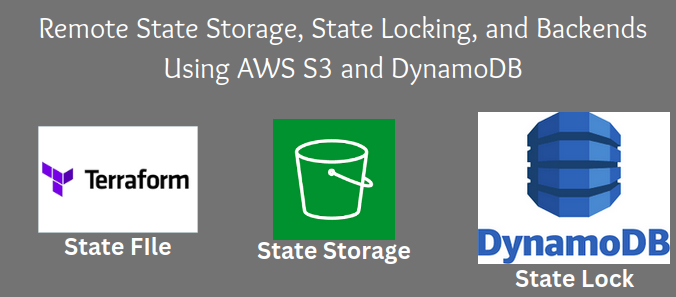Implementing and Maintaining State in Terraform

Terraform's state management is a fundamental aspect of infrastructure as code, ensuring that the infrastructure resources match the desired configuration. This article explores key concepts, practical examples, and best practices for effectively implementing and maintaining Terraform state.
1. Default Local Backend
The default local backend stores the Terraform state file (terraform.tfstate) locally on the machine where Terraform is executed.
Key Characteristics:
Stores the state as a file in the current working directory.
Requires no additional configuration.
Suitable for small projects or development environments.
Practical Example:
Create a basic Terraform configuration:
resource "aws_s3_bucket" "example" { bucket = "example-bucket" }Run the commands:
terraform init terraform applyThe
terraform.tfstatefile is created in the working directory.
2. State Locking
State locking prevents multiple processes from modifying the state simultaneously, avoiding potential conflicts and race conditions.
Key Concepts:
Default Local Backend: No locking mechanism.
Remote Backends: Support state locking using mechanisms like DynamoDB (for S3).
Practical Example (S3 Backend with Locking):
Configure S3 backend with DynamoDB for locking:
terraform { backend "s3" { bucket = "example-tf-state" key = "state/terraform.tfstate" region = "us-east-1" dynamodb_table = "example-lock-table" } }Create a DynamoDB table for locking:
aws dynamodb create-table --table-name example-lock-table \ --attribute-definitions AttributeName=LockID,AttributeType=S \ --key-schema AttributeName=LockID,KeyType=HASH \ --provisioned-throughput ReadCapacityUnits=1,WriteCapacityUnits=1
3. Backend and Cloud Integration Authentication Methods
Terraform integrates with cloud providers and backends using authentication mechanisms such as credentials files, environment variables, or CLI tools.
Examples:
AWS:
Use AWS CLI:
aws configureUse environment variables:
export AWS_ACCESS_KEY_ID="your_access_key" export AWS_SECRET_ACCESS_KEY="your_secret_key"
Azure: Authenticate using Azure CLI or service principal credentials.
GCP: Use a JSON credentials file or gcloud CLI.
4. Remote State Backend Options
Remote backends allow centralized storage and management of the Terraform state file, enabling collaboration and scalability.
Popular Backends:
| Backend | Locking | Encryption | Access Control | Collaboration |
| Local | No | No | File System | No |
| S3 (with DynamoDB) | Yes | Yes | IAM Policies | Yes |
| Azure Blob Storage | Yes | Yes | Azure RBAC | Yes |
| Terraform Cloud | Yes | Yes | User Roles | Yes |
Example (S3 Backend):
terraform {
backend "s3" {
bucket = "example-tf-state"
key = "state/terraform.tfstate"
region = "us-west-2"
encrypt = true
dynamodb_table = "example-lock-table"
}
}
5. Managing Resource Drift
Resource drift occurs when infrastructure changes are made outside Terraform. Detecting and addressing drift is essential to maintain the desired state.
Steps to Manage Drift:
Detect drift using:
terraform planReapply the desired state:
terraform applyRefresh the state manually:
terraform refresh
6. Backend Block and Cloud Integration in Configuration
The backend block defines where Terraform stores its state.
Example:
terraform {
backend "s3" {
bucket = "secure-state"
key = "prod/terraform.tfstate"
region = "us-west-2"
encrypt = true
}
}
7. Secret Management in State Files
Terraform state files can contain sensitive data, such as passwords or API keys. Protecting this data is critical.
Best Practices:
Use Remote Backends with Encryption:
- Enable encryption for S3, Azure, or other backends.
Mark Variables as Sensitive:
variable "db_password" { type = string sensitive = true }Restrict Access:
- Apply strict IAM policies to remote backend resources.
Example (Securing Sensitive Data):
Store sensitive data in a secure backend:
terraform { backend "s3" { bucket = "secure-state" key = "prod/terraform.tfstate" encrypt = true } }Mask sensitive outputs:
output "db_password" { value = var.db_password sensitive = true }
Conclusion
State management in Terraform is a critical aspect of managing infrastructure. By understanding and applying best practices, such as enabling state locking, using remote backends, and protecting sensitive data, you can ensure the integrity and security of your infrastructure. Leveraging these strategies enables efficient collaboration and maintains the consistency of your infrastructure state.